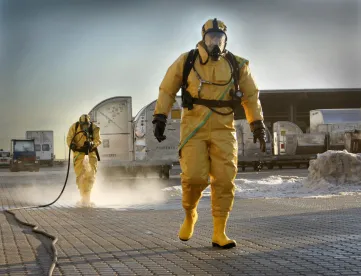On April 10, 2020, US EPA issued updated interim guidance to regional offices for dealing with the “challenges posed by the COVID-19 situation.” The guidance applies to all US EPA field activities, including cleanup under the Superfund program, RCRA corrective action, TSCA PCB cleanup provisions, the Oil Pollution Act, and the Underground Storage Tank program. The interim guidance supersedes US EPA’s March 19, 2020 guidance. Critically too, US EPA’s new interim guidance assumes ongoing operations and field work unless certain COVID-19-related circumstances exist. This guidance thus differs from initial guidance from US EPA, which suggested that US EPA might stop enforcement and remediation efforts during the COVID-19 situation more broadly.
Priorities
US EPA will make decisions about continuing on-site activities “on a case-by-case basis,” giving priority to the following Agency values:
- Protecting the health and safety of the public, as well as maintaining the health and safety of US EPA staff and cleanup partners;
- Maintaining US EPA’s ability to prevent and respond to environmental emergencies and to protect public health and welfare and the environment.
The interim guidance emphasizes that these priorities will inform US EPA regional office decisions about work as well as “decisions based on requests from outside parties (e.g., states, tribes, local governments, other federal agencies, potentially responsible parties, property owners, etc.) for extensions or delays in performance.”
Delayed Performance & Communication
Complementing its two overarching priorities, US EPA’s interim guidance explains that parties affected by any resulting restrictions, including those who may “delay their performance obligations,” should “consult the applicable enforcement instrument.” The enforcement instrument will often include provisions allowing for adjustments to schedules to be made at the discretion of EPA’s project manager or force majeure provisions. Additionally, US EPA “encourages parties (and the lead agency of Federal Facility Superfund sites) to regularly communicate with [US] EPA project managers about the status of their sites and associated field work and any anticipated challenge and mitigation measures.” US EPA will modify a party’s performance obligations on a “case-by-case basis,” depending on “site-specific circumstances,” the “type of work that is affected by COVID-19,” and the “applicable enforcement instrument.”
The interim guidance emphasizes that US EPA’s regional offices should “provide notification to, coordinate with, and collaborate with States, Tribes, and other Federal agencies to optimize communications and share information about the status of particular response work.”
Examples of Reduced or Suspended Response Actions
US EPA’s interim guidance notes that Regions have decided and may continue to decide to reduce or suspend response actions at particular sites for the following or similar situations:
- State, tribal, or local health officials have requested particular site operations or types of operations that would pertain to particular sites be suspended;
- Any site where workers have tested positive for or exhibited symptoms of COVID-19;
- Any sites where there may be close interaction with high-risk groups or those under quarantine, such as work inside homes;
- Sites where contractor field personnel are not able to work due to state, tribal, or local travel restrictions or medical quarantine;
- Other sites where social distancing is not possible.
These situations provide instructive guidance for what circumstances might allow a party to delay or suspend response actions. As important, given the new interim guidance and the fluid nature of the COVID-19 situation, parties should expect additional representative situations arise, further clarifying when a might party delay or suspend response actions.
Site-Specific Factors
US EPA’s interim guidance also identifies three site-specific factors that “should be part of a Region’s decision regarding whether response actions will be continued, be reduced, or be paused.” The first factor is “whether failure to continue response actions would likely pose an imminent and substantial endangerment to human health or the environment, and whether it is practical to continue such actions.” The interim guidance notes that certain “Emergency Responses (including Superfund and Oil Spill Responses) may warrant additional cleanup to “address imminent threat to public health and welfare and the environment.”
The second factor is that each Region should evaluate “whether maintaining any response actions would lead to a reduction in human health risk/exposure within the ensuing six months.” The interim guidance anticipates, for instance, that “drinking water work” may need to continue to protect human health.
The final factor is “whether work that would not provide near-term reduction in human health risk could be more strongly considered for delay, suspension, or rescheduling.” As an example, the US EPA identifies “remediation of otherwise stable conditions” as potentially appropriate for delay, suspension, or rescheduling.
Non-Field Site Work
US EPA’s interim guidance requires “advance cleanup of sites” that “is performed away from sites” to continue. The only exception is where the COVID-19 situation causes “work that normally takes place away from the site” to “be impacted.” And, in that circumstance, parties “may delay their performance of non-field related work.” Consistent with this guidance, parties should consider the factors relevant to delay, suspend, or reschedule field work in determining how US EPA will evaluate any requested delay for non-field work.
What is next?
US EPA will likely continue to provide guidance and instruction as the situation with COVID-19 unfolds. In particular, we anticipate further interim guidance and instruction from US EPA.




 />i
/>i

